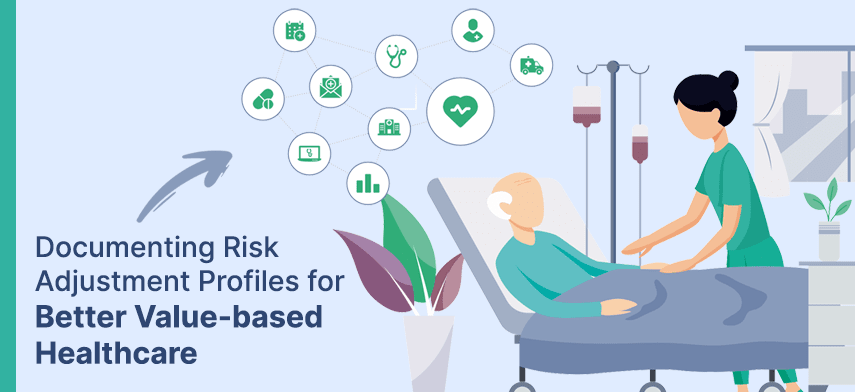
A basic component of modern healthcare, risk adjustment is essential to ensuring that healthcare professionals are paid fairly and accurately. Risk adjustment, in its essence, is a complex procedure painstakingly created to take into account differences in patient health, ensuring that payment reflects the real degree of treatment required.
This in-depth blog explores the significance, methodology, associated difficulties, and, most importantly, the profound impact that risk adjustment has on the overall standard of patient care.
Understanding Risk Adjustment
Healthcare risk adjustment is a complex process that involves altering payments in accordance with patient health. This mechanism’s main goal is to account for variations in patient health while promoting fair payment of healthcare providers.
It serves as a check against financial incentives for healthcare professionals who provide for people with complex medical demands. In essence, risk adjustment ensures a fair and just compensation model by matching financial incentives with the patient’s actual health requirements.
Methods of Risk Adjustment
The Hierarchical Condition Categories (HCCs) model stands out as a cornerstone methodology in the complex world of risk adjustment. This widely accepted method systematically classifies diagnoses into different categories using a hierarchical structure. To appropriately determine the overall danger posed by a patient is the goal, which is obvious.
Coding Precision
The accuracy of medical condition coding is essential to HCCs’ efficacy. The system uses a complex coding scheme to capture the unique intricacies of a patient’s health. In order to appropriately depict the severity of illnesses and support a more nuanced risk assessment, this precision is essential.
Demographic Considerations
Beyond the clinical components, HCCs considers important demographic variables that have a big impact on a person’s health needs. Recognizing the various healthcare needs connected with various demographic segments, age and gender are taken into account as essential components. This sensitivity to demographics ensures a more individualized and precise risk assessment.
Emphasis on Chronic Conditions
In the HCCs model, the severity of chronic illnesses becomes crucial in determining risk scores. Chronic diseases are given more attention because of their long-lasting effects on health. The model takes into account the need for a more continuous and resource-intensive approach to managing chronic illnesses, which affects the following reimbursement amounts.
Challenges in Risk Adjustment
Accuracy of Medical Documentation
The accuracy of medical records is closely related to a key issue in the field of risk adjustment. The accuracy and precision of these records are crucial to the efficacy of risk scores. Risk evaluations may be considerably distorted by incomplete or faulty paperwork, which may result in incorrect compensation amounts.
To address this issue, a deliberate effort must be made to improve the quality and completeness of medical records, highlighting the significance of rigorous documenting procedures.
Complexity in Coding of Medical Conditions
Another significant difficulty in risk adjustment is the coding complexity linked to complex medical disorders. As medical research develops, illnesses become more complex and call for more precise categorization.
Healthcare personnel must have ongoing training and education if they are to be capable of correctly coding complex medical settings. To meet the challenge offered by the growing complexity of medical diseases, this continual education is essential.
Socioeconomic Factors and Health Outcomes
Addressing the impact of socioeconomic determinants on health outcomes is a unique challenge for risk adjustment. These non-clinical determinants of health, which range from social support systems to economic position, have a big impact on a person’s wellbeing. Including these aspects in risk adjustment models necessitates a sophisticated and thorough strategy.
Failure to take these factors into consideration could lead to an incomplete picture of a patient’s health risks and possibly insufficient risk scores. To address this issue, risk models must be improved to include socioeconomic factors, resulting in a more complete and precise evaluation of health hazards.
Impact on Patient Care
Risk adjustment has a significant impact on patient care since it serves as a motivator for encouraging all-encompassing healthcare. Risk adjustment enables healthcare providers to take a comprehensive approach to patient well-being by taking into consideration the complexity and severity of patients’ diseases.
Promoting Preventive Care and Early Interventions
The encouragement of early intervention and preventive care is at the core of risk adjustment’s impact on patient care. The strategy supports the larger healthcare objective of proactive health management by recognizing the need to prevent health issues before they worsen. Risk adjustment incentivizes medical professionals to give preventative actions the highest priority by taking into account the potential hazards connected to a patient’s medical issues.
Quality Improvement as a Direct Outcome
The idea of patient care quality improvement is closely related to risk-adjusted reimbursement. Risk adjustment naturally links reimbursement levels to the calibre of treatment given because it considers not only the likelihood of medical events but also their severity and impact. The pursuit of better patient outcomes turns into a business imperative as well as a moral one, resulting in a cycle of ongoing quality improvement in the provision of healthcare.
Embracing a Patient-Centred Approach
The patient-centred approach incorporated into risk adjustment is perfectly in line with the larger healthcare narrative that places an emphasis on outcomes rather than transactions. Patients receive care throughout their whole health journey rather than just during specific medical episodes. Risk adjustment urges medical professionals to evaluate patients holistically, taking into account not only their current health but also their long-term welfare.
Conclusion
Risk adjustment is a crucial technique for negotiating the difficulties of contemporary healthcare. It makes sure that everyone is paid fairly, encourages high-quality care, and lines up financial incentives with the patients’ actual healthcare needs. The importance of risk adjustment is emphasized in this guide, which also provides information on its approaches, difficulties, and significant effects on patient outcomes. Healthcare professionals can better manage the system’s intricacies and contribute to a more just and patient-focused healthcare environment by understanding these dynamics.